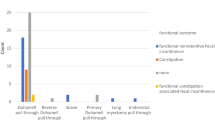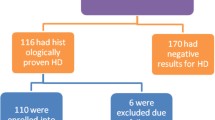Abstract
Purpose
Although significantly decreased during last decades, mortality rate for Hirschsprung’s disease still ranges between 1 and 10%. The authors reviewed the main features of patients with Hirschsprung’s disease treated in our Institution who died in the period between 1993 and 2010 in order to detect possible risk factors or prevention strategies.
Methods
The notes of all patients with Hirschsprung’s disease admitted to our Institution between January 1993 and January 2010 were reviewed. All families were interviewed and possible unknown deaths were recorded. We reported demographic data, length of aganglionosis, type and number of associated anomalies, age and type of onset, age and cause of death, chronological relationship between death and pull-through, and all other significant details.
Results
Eight out of a series of 313 patients with Hirschsprung’s disease died during the study period (mortality rate = 2.56%). Six patients were male for a male to female ratio of 3:1. Eleven associated anomalies were detected in five patients, including four congenital anomalies of the kidney and urinary tract, four heart, two central nervous system, and one skeletal malformations. One patient had Down Syndrome and one Cat Eye Syndrome. Two patients were born preterm. All patients had neonatal onset with delayed meconium passage. Five patients had aganglionosis confined to rectosigmoid colon (classic forms), two had total colonic aganglionosis and one had total intestinal aganglionosis. Enterostomy was performed in five patients. Median age at death was 75 days (range 30 days–8 years). The cause of death was enterocolitis in four patients, heart failure in three, and intestinal failure in one. Six patients died before the pull-through. Two patients died postoperatively. All patients but two died at home.
Conclusions
Onset and clinical features do correlate with severity. Newborns and infants seem to be more likely to develop serious life-threatening complications, particularly in case of associated cardiovascular malformations. Although enterostomies do not have protective effects over cardiovascular issues, prophylactic stoma should be considered in high-risk patients. Radical treatment (pull-through) should be performed as soon as possible. Alternatively, protected and cautious discharge of newborns with associated heart anomalies is strongly recommended in order to prevent serious and uncontrolled complications, regardless of the presence of a protective enterostomy. Postoperatively, close follow-up appointments are recommended. Families should be acknowledged and educated for prompt recognition and treatment of severe life-threatening complications.
Similar content being viewed by others
References
Swenson O (2004) Hirschsprung’s disease—a complicated therapeutic problem: some thoughts and solutions based on data and personal experience over 56 years. J Pediatr Surg 39(10):1449–1453
Sherman JO, Snyder ME, Weitzman JJ et al (1989) 40-year multinational retrospective study of 880 Swenson procedures. J Pediatr Surg 24:833–838
Suita S, Taguchi T, Ieiri S, Nakatsuji T (2005) Hirschsprung’s disease in Japan: analysis of 3852 patients based on a nationwide survey in 30 years. J Pediatr Surg 40:197–202
Fouquet V, De Lagausie P, Faure C, Bloch J, Malbezin S, Ferkhadji L, Bauman C, Aigrain Y (2002) Do prognostic factors exist for total colonic aganglionosis with ileal involvement? J Pediatr Surg 37(1):71–75
Yanchar NL, Soucy P (1999) Long-term outcome after Hirschsprung’s disease: patients’ perspectives. J Pediatr Surg 34(7):1152–1160
Ruttenstock E, Puri P (2009) A meta-analysis of clinical outcome in patients with total intestinal aganglionosis. Ped Surg Int 25:833–839
Tsuji H, Spitz L, Kiely EM, Drake DP, Pierro A (1999) Management and long-term follow-up of infants with total colonic aganglionosis. J Pediatr Surg 34(1):158–162
Wildhaber BE, Teitelbaum H, Coran AG (2005) Total colonic Hirschsprung’s disease: a 28-year experience. J Pediatr Surg 40:203–207
Menezes M, Pini Prato A, Jasonni V, Puri P (2008) Long-term clinical outcome in patients with total colonic aganglionosis: a 31-year review. J Pediatr Surg 43:1696–1699
Murthi GVC (2003) Raine PAM. Preoperative enterocolitis is associated with poorer long-term bowel function after Soave-Boley endorectal pull-through for Hirschsprung’s disease. J Pediatr Surg 38(1):69–72
Hackam DJ, Reblock K, Barksdale EM, Redlinger R, Lynch J, Gaines BA (2003) The influence of Down’s Syndrome on the management and outcome of children with Hirschsprung’s disease. J Pediatr Surg 38(6):946–949
Morabito A, Lall A, Gull S, Mohee A, Bianchi A (2006) The impact of Down Syndrome on the immediate and long-term outcome s of children with Hirschsprung’s disease. Ped Surg Int 22:179–181
Menezes M, Puri P (2005) Long-term clinical outcome in patients with Hirschsprung’s disease and associated Down’s syndrome. J Pediatr Surg 40:810–812
Rescorla FJ, Morrison AM, ENgles D, West KW, Grosfeld JL (1992) Hirschsprung’s disease. Evaluation of mortality and long-term function in 260 cases. Arch Surg 127(8):934–941
Mills JLA, Konkin DE, Milner R, Penner JG, Langer M, Webber EM (2008) Long-term bowel function and quality of life in children with Hirschsprung’s disease. J Pediatr Surg 43:899–905
Reding R, de Ville de Goyet J, Gosseye S, Clapuyt P, Sokal E, Buts JP, Gibbs P, Otte JB (1997) Hirschsprung’s disease: a 20-year experience. J Pediatr Surg 32(8):1221–1225
Pini Prato A, Gentilino V, Giunta C, Avanzini S, Parodi S, Mattioli G, Martucciello G, Jasonni V (2008) Hirschsprung’s disease: 13 years’ experience in 112 patients from a single institution. Ped Surg Int 24(2):175–182
Marty TL, Seo T, Sullivan JJ, Matlak ME, Black RE, Johnson DG (1995) Rectal irrigations for the prevention of postoperative enterocolitis in Hirschsprung’s disease. J Pediatr Surg 30(5):652–654
Tander B, Rizalar R, Cihan AO, Ayyildiz SH, Ariturk E, Bernay F (2007) Is there a hidden mortality after one stage transanale endorectal pull-through for patients with Hirschsprung’s disease? Ped Surg Int 23:81
Elhalaby EA, Hashish A, Elbarbary MM, Soliman HA, Wishahy MK, Elkholy A, Abdelhay S, Elbehery M, Halawa N, Gobran T, Shehata S, Elkhouly N, Hamza AF (2004) Transanal one-stage endorectal pull-through for Hirschsprung's disease: a multicenter study. J Pediatr Surg 39(3):345–351
Author information
Authors and Affiliations
Corresponding author
Rights and permissions
About this article
Cite this article
Pini Prato, A., Rossi, V., Avanzini, S. et al. Hirschsprung’s disease: what about mortality?. Pediatr Surg Int 27, 473–478 (2011). https://doi.org/10.1007/s00383-010-2848-2
Published:
Issue Date:
DOI: https://doi.org/10.1007/s00383-010-2848-2




